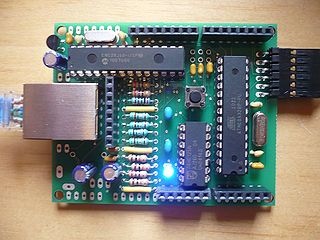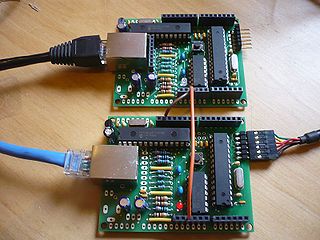Project:Nanode: Difference between revisions
| Line 35: | Line 35: | ||
* 2 - [[User:Ascen|asc]] | * 2 - [[User:Ascen|asc]] | ||
* 1 - [[User:matthewvenn]] | * 1 - [[User:matthewvenn]] | ||
* 4 - [[User:MarkStan]] | * 4 - [[User:MarkStan|Mark]] | ||
==The First Prototypes== | ==The First Prototypes== | ||
Revision as of 16:22, 30 March 2011
New page for Ken's new project 'Nanode' (formerly 'Ethernet Arduino')
About the Nanode - Some Background
The Nanode is a low cost entry device aimed at Internet Connectivity projects. It has been designed to be built easily for under £20 - so that it will appeal to those on a tight budget.
It is based on the Arduino environment so will be familiar to many. It will accept Arduino shields, if necessary with longer pins to mprove clearance between the Magjack connector and the underside of the shield.
It consists of a small PCB which has the ATmega328 microcontroller, some glue logic, the ENC28J60 ethernet controller and Magjack. The board only uses through-hole and DIL conventional components - so that it can be easily assembled by anyone who has bassic solderng skills.
It makes an ideal project for a teaching workshop on web connectivity, and as such will appeal to Hackspaces for advanced Arduino workshops.
It can be used as a micro web-server, for home automation and control, web connected sensor networks and many other applications. By removing the ethernet controller and Magjack, it becomes a low cost Arduino "work-alike".
Several Nanodes can be connected together on a multidrop serial bus. This network supplies communications and power and can be made from low cost 4 core telephone cable. Individual Nanodes can communicate via this network back to an ethernet connected "Master" unit. With RS485 driver ICs, the Nanode can be adapted as a DMX lighting controller, MIDI network or other serial control system.
Nanode is an Open Source Project.
Bare board waiting list
This is the waiting list for the first production run' of bare PCBs.
Please add the number of PCBs that you would like with your name to the list below:
- 4 - Spike
- 4 - Elliot
- 2 - Artag
- 4 - Bob/b3cft
- 2 - Catie
- 2 - V21 14:07, 30 March 2011 (UTC)
- 2 - asc
- 1 - User:matthewvenn
- 4 - Mark
The First Prototypes
Here are the two boards each connected to a network port. The orange and brown wires between the boards is so that they can share the 5V power from the FTDI cable.
The upper board is the Publisher (Putter) and the lower board is the Subscriber (Getter). Every few seconds the Putter sends a new packet of data up to Pachube feed 8729, and at regular intervals the Getter subscribes to this feed to retrieve the data. In this case the data is a simple comma separated list of 6 arguments, which could be six readings from the ADCs on the Putter device, or a numerical command to which the Getter will respond.
Building a Nanode
The complete step by step build sequence can be found on my blog
Parts List
Most parts are readily available. I recommend Cool Components in South London for several of the key items.
* 1 ATmega328 microcontroller (with Arduino bootloader) - CoolComponents £5.00 (£2.81 without bootloader) * 1 ENC28J60 ethernet controller - CoolComponents 1.99 * 1 Magjack - CoolComponents £1.99
The remainder of the parts came from Farnell Components or other suppliers eg Rapid Electronics:
* 1 74AHC125 quad buffer 174-9617 * 1 16MHz crystal 161-1761 * 1 25MHz crystal 161-1783 * 4 22pF ceramic capacitors 114-1760 * 8 100nF ceramic capacitors 121-6444 * 2 10nF ceramic capacitors 121-6435 * 3 10uF electrolytic capacitors 945-1056 * 1 7805 5V regulator 156-4483 * 1 78L33 3V3 regulator 146-7768 * 1 2K resistor 934-1480 * 4 51ohm 1% resistors 934-3342 * 3 270 ohm resistors 933-9353 * 3 10K resistors 933-9060 * 1 tact switch 181-3689 * 2 8 way 0.1" SIL Sockets * 2 6 way 0.1" SIL Sockets * 1 6 way 0.1" right angle header * 1 2.1mm dc jack socket * 1 1N4001 diode * 1 3mm LED * 2 32 pin 0.1" header strips (for optional I/O connectors).
You will also need:
* 1 Nanode pcb - available shortly to Hackspace members * 1 FTDI USB-serial cable - becoming a standard bit of kit for talking to microcontrollers. * 1 CAT5 network cable to connect to router

